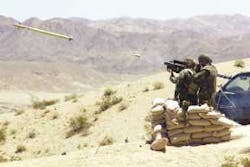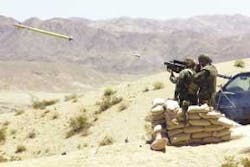By John McHale
WASHINGTON — Officials at the U.S. Department of Homeland Security's (DHS) Science and Technology division selected industry teams to compete in Phase I of a program to develop systems to protect commercial aircraft from shoulder-fired missiles such as the U.S. Stinger and Russian SA-18.
Leading these teams are BAE Systems Information & Electronic Warfare Systems (IEWS) in Nashua, N.H., Northrop Grumman's Defensive Systems division in Rolling Meadows, N.Y., and United Airlines in Chicago.
The teams are looking into prototypes that will help determine whether a viable technology exists to address the potential threat of man-portable air-defense systems (MANPADS) to commercial aircraft.
The industry teams each will receive approximately $2 million for the first six-month phase of the program to plan how to adapt military anti-missile technologies for commercial aircraft, rather than developing new technology, department officials say.
One or two contractors will move on to the 12-to-18-month phase II to develop prototypes using existing military or commercial technology. Funding for the Counter-MANPADS Program will use $2 million from the federal 2003, budget, $60 million from the 2004 budget, and has asked for $60 million more in 2005, DHS officials say.
One likely technology for the program is the Directed Infrared Countermeasure (DIRCM), an infrared device that jams missile guidance systems from BAE Systems.
DIRCM passively detects the plume of an IR-guided missile and classifies the threat as lethal (it is aimed at the aircraft), nonlethal (will not intercept the aircraft) or clutter, BAE Systems officials say. The system alerts the crew and autonomously activates a high-power modulated arc lamp, which tracks and defeats the threat by confusing the missile's heat-seeking sensor, company officials say.
BAE Systems officials are basing it on their Advanced Threat Infrared Countermeasure (ATIRCM) system, says Bruce Keirstead. However it will take advantage of the deployable IR laser countermeasures capability of the BAE Systems's Tactical Aircraft Directable Infrared Countermeasures (TADIRCM) system, which is used by the U.S. Navy.
The TADIRCM enables modern infrared air-to-air missile launched at tactical fighters to be defeated by an on-board laser-based directional infrared countermeasures system, company officials say.
The system includes six two-color infrared staring sensors, a signal processor, a modulated IR laser, and two compact pointer/trackers. The TADIRCM detects and tracks incoming missiles, and then decisively jams them with its IR laser and pointer/tracker, BAE Systems officials say.
Northrop Grumman officials are proposing a system based on their Large Aircraft Infrared Countermeasure (LAIRCM) unit, which uses Directed Infrared Countermeasure (DIRCM) techniques, says Jack Pledger, director of Infrared Countermeasures business development at Northrop Grumman. LAIRCMs defeat the threat missile guidance system by directing a high-intensity modulated laser beam into the missile seeker. However, these technologies are generally used by military and heads-of-state aircraft, which have the operations and maintenance infrastructure to support the systems, DHS officials say.
Northrop Grumman's anti-missile devices are currently deployed on a variety of U.S. and U.K. military aircraft operating worldwide, including C-17 and C-130 military transports.
The technology currently used by the military is sound, but the tough part will be dealing with the logistics — such as maintenance schedules — in adapting the technology for use by commercial airliners, Pledger says. "We have to coordinate the airline's needs with that of DHS."
Drag and weight are also a major concern of the airlines and DHS. "They fuels projection costs, because increased weight and drag increases the amount of fuel needed which can get expensive," Pledger says.
The United Airlines proposal — the Commercial Aircraft Protection System (CAPS) — uses the ATK's AN/AAR-47 missile-warning system from Alliant Techsystems (ATK) in Edina, Minn. This system uses expendable decoys.
The decoys are not flares but have a special material that provides a heat source in the infrared spectrum not visible to naked eye, says Steve Myers, vice president of operations for ATK in Clearwater, Fla. The decoys give off an intense heat source that burns out by time it hits the ground, greatly reducing the potential for collateral damage, he explains.
During a test drop from 100 feet the decoys were burned out and cold when they hit the ground, says Bryce Hallowell, ATK spokesman. The ATK AN/AAR-47 is already operational on more than 1,100 U.S. and allied military aircraft.
Hallowell says the commercial system is flush-mounted, which is an important differentiator because aerodynamics are important to commercial airliners because of the drag/fuel issues and costs.
The United Airlines team also includes AVISYS in Austin, Texas, Thales Airborne Systems in Crawley, England, Symetrics Industries in Melbourne, Fla., L-3 Communications Integrated Systems in Greenville, Texas, Alloy Surfaces Co. in Aston, Pa., ARINC, the Naval Air Warfare Center Weapons Division in China Lake, Calif., the Georgia Institute of Technology in Atlanta, and Armtec Defense Products in Coachella, Calif.




